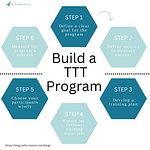Here’s a quick summary of what I learned in my career, which led me to a major change in mindset that I think we all need to make. A lot of training designers have taken a similar path. Maybe you’re one of them.
Technical training: Job aids rule!
I started out in the early 1980s as a technical trainer, introducing people to the newfangled IBM PC. It was also my job to provide tech support. If people didn’t learn something well, they called me with questions, so I quickly learned which training techniques worked.
Creating job aids and practice activities became my favorite way to help new PC users become independent.
Education: Stuff knowledge into their heads, but don’t let them think
Next, I got a university job creating “distance learning” materials, which turned out to be written lectures. Then I got a job designing elearning for US schoolchildren, and then I wrote activities for standardized tests.
Each activity I wrote for children had to cover an item in a long list that specified what kids should know at each age. School systems in the US use such a list to design their lessons. Standardized tests determine whether the kids have “learned” each item.
The items were so specific that each activity presented one bit of knowledge divorced from other knowledge. The student spent ten minutes on chlorophyll and then ten minutes on magma. We delivered snippets of information with no connecting concepts because our goal was for kids to pass test questions about each snippet.
Emotionally charged, pseudoscientific claims about how children learn dominated the scene. Feelings seemed more important than clear thinking, and clear thinking seemed impossible thanks to the stream of disconnected bits of knowledge we created.
In 2001, I switched to the corporate elearning market.
Corporate elearning: Stuff knowledge into their heads, part 2
I happily worked for award-winning elearning development firms and then independently, with clients who ranged from consultants to global corporations.
I loved my work, but as I looked at the larger field of corporate training, I began to see barriers to good design. They reminded me of issues I had seen when I worked in education.
Often, the client saw a performance problem and assumed that a course was the solution. Like in education, the course designer’s job was to cover the information that someone else had specified and then test learners’ ability to recall it.
As slide-based elearning took hold, the information was increasingly delivered as unrelated bits of content, a few bullet points per slide, just like the disconnected bits of knowledge I had helped deliver in my education jobs.
Finally, the pseudoscientific beliefs I had seen in the education world were increasingly used as rules for training design. For example, redundant narration became popular out of a misguided belief that “auditory” learners couldn’t learn from pictures or text.
The practical job aids from the beginning of my career had almost completely disappeared. The prevailing belief was that a course would inject people with what they needed to know.
As I looked around our field, I saw only well-intentioned people who were trying to improve performance or improve the world. But the “knowledge transfer” mindset meant that we created materials that weren’t very different from the materials I had created in education, and they seemed likely to fail.
It was hard to tell if they actually failed, because usually no one checked. Like in education, often the only measurement was the final test, which just checked to see if bits of knowledge survived in people’s short-term memory five minutes after the training was done.
Trying to deprogram myself
I no longer agreed with what we designers were supposed to do, and I wanted to propose alternatives. However, I had trouble imagining any alternatives until I read Michael Allen’s Guide to Elearning in about 2004. He pointed out that we need to move from “tell, then test” to “test, then tell.”
I also learned from a client who wanted to use a simulation to help people practice using his sales model. Working with him showed me how we can let people learn by doing, even in self-paced elearning.
When I moonlighted with marketing firms, I saw that marketers have the same goal as trainers, to change people’s behavior. However, good marketers create business goals to justify the expense of a project, and they measure (in a million ways!) whether people actually change their behavior.
Finally, I still remembered my early days, when I gave new PC users practice activities and created help screens and job aids. I had seen those work well, so I couldn’t agree that a course was always the best solution.
I developed action mapping to give designers a ladder down from the clouds of knowledge to the real world. The model is intended to help everyone involved in a project clearly see the real-world change they need to create, identify the barriers to that change, and, when appropriate, to design practice activities, not just information, to create that change.
This is one of several FAQs about action mapping and instructional design as a career.
Scenario design toolkit now available
Design challenging scenarios your learners love
- Get the insight you need from the subject matter expert
- Create mini-scenarios and branching scenarios for any format (live or elearning)
It's not just another course!
- Self-paced toolkit, no scheduling hassles
- Interactive decision tools you'll use on your job
- Far more in depth than a live course -- let's really geek out on scenarios!
- Use it to make decisions for any project, with lifetime access








